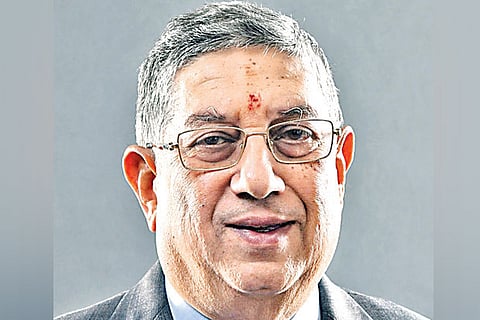

Chennai
N Srinivasan, VC-MD, India Cements, said it can no longer “afford a bad quarter” and in such a scenario, it had to “reinvent and revisit” its strategy and operational models so that the company and the industry, in general, can find its feet and back to robust growth. “We were caught by surprise… tricky than we thought as we did not expect the slump post-elections (when the present government came back to power for a second consecutive time). Our predictive capacity has to improve,” he said, adding infra projects had to take off in reality.
Observing that cement business has traditionally been a long-haul one, typically 10-15 years, he said it is “not an industry that can be chopped up into quarters and reported about.” Even at the current GDP growth, the sector had enough capacity to overtake demand, but for that to happen, the infra projects have to be implemented on the ground, thereby creating demand. “If the promised infra push happens, then demand will be good,” Srinivasan said, highlighting the fact that Salem-Bengaluru highway project that had not yet seen progress.
Though the financial year started off well, the momentum of demand in Q1 was affected, owing to infra projects getting stalled in places like Andhra. Between Telangana and Andhra, a demand of 32 lakh tonnes per month, declined to 12 lakh tonnes in August last. “Everyone is chasing the same demand,” said Srinivasan, noting that combination of restraint to not sell below a certain price and lack of demand had led to dip in performance.
He also pointed out that the lack of availability of limestone in the north and east (30 per cent of limestone is in Andhra/Telengana and 10 per cent or so in Gulbarga, Karnataka) had made it difficult to operate from a logistics perspective. “If a freight equalisation scheme to move cement seamlessly into north” is announced by the government, it would help, he said. Incidentally, the company’s net plant realisation (NPR) had declined from Rs 3,654 in the Q1 to Rs 3,342 per tonne in Q3 (Rs 3,308 during Q3 of last year). In the preceding quarter of this year, it was Rs 3,501.
India Cements is upbeat about individual housing projects, that have spurred demand beyond metros. TN is 18-19 lakh tonnes market, of which Chennai comprises 3 lakh tonnes. Unlike this region, a stronghold, the pricing factor in other locations of the country had made India Cements look beyond south. If in Jharkhand, it has seen better realisation than even exports, it has been constrained by rail wagon availability challenges. A price hike of Rs 35 per bag in Kerala, Rs 30-35 in Karnataka, Rs 70 in Andhra/ Telangana, Rs 30 in Maharashtra, Rs 15 in Rajasthan, Gujarat and Madhya Pradesh and Rs 20 in the east, has either been absorbed or shown good reaction. In TN, where the price announcement of Rs 30 per bag has just been announced, Srinivasan feels it is “slightly sluggish” but if the market is able to absorb the hike, then it would contribute to putting the company back into black.
India Cements’ total income stood at Rs 1,194 crore against Rs 1,248 crore. The gross profit (EBIDTA) was Rs 132 crore against Rs 139 crore in the same period last year.
Visit news.dtnext.in to explore our interactive epaper!
Download the DT Next app for more exciting features!
Click here for iOS
Click here for Android